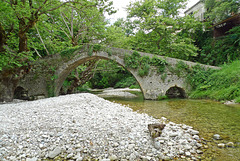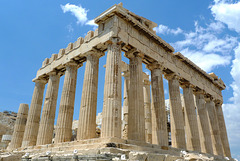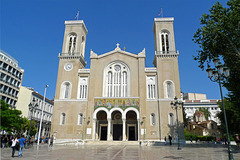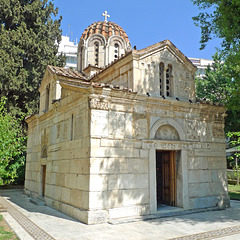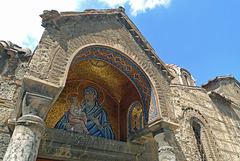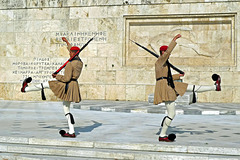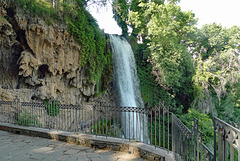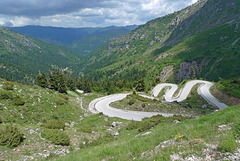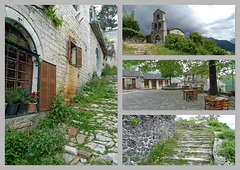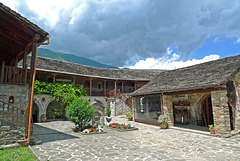
Greece - Ελλάδα - Griekenland
Greece - Church of Panagia Vlacherna
| |
|
|
|
The Byzantine Church of Panagia Vlacherna (Virgin Mary Church) is one of the most important Byzantine monuments of the medieval Epirus state. Initially it was dedicated to the Assumption of Mary. The church was initially the catholicon of a women’s monastery. Nowadays it serves at the parish church of the settlement of Vlacherna.
The church is built atop a middle-byzantine era basilica (late 9th – early 10th century). The central arch of which consists as an arch of the current church. In the early 13th century the Vlacherna Church was built as three-aisled wooden roof basilica, which a few years later was transformed into the vaulted type with the addition of the domes. In the second half of the 13th century the narthex was added on the west side.
The nave has important frescoes from the mid 13th century, while the frescoes in the narthex are from the end of the same century. The marble relief iconostasis is of remarkable craftsmanship.
Greece - Volos, Saint Nicholas Orthodox Metropolit…
| |
|
|
|
The pericircular - Byzantine dome - Metropolitan Church of St. Nicholas of Volos was built on the initiative of the respective Mayors and Municipal Councils of the city. It was founded in 1928 and inaugurated at the end of 1934 by the then Metropolitan of Demetrias Germanos.
The church is the work of the architect Aristotle Zachos and is built on the foundations of an older church that was burned down in1898. The unique art of the baroque style bell tower was built between 1886 - 1890 by Italian craftsmen. It was severely damaged by the 1980 earthquakes and was restored as a listed monument with the same marble in 1999.
Greece - Vrosina, bridge
| |
|
|
|
Some pictures of the stone single-arched stone bridge in Vrosina. Its construction was funded by the Makralexis Monastery The bridge crosses the river Zaloggitikos just before it flows into the Kalamas.
I estimate the bridge is dating back to the end of the 19th century, like a lot of other stone bridges in Epirus. But to be honest I couldn’t find much information about the bridge. Even two friendly and helpful Vrosina-women were not able to find important information about its history on the internet.
Greece - Monument of Zalongo
| |
|
|
|
The Monument of Zalongo - placed in 1961 - commemorates the so called ‘Dance of Zalongo’, referring to a mass suicide of women and children in 1803 during the Souli War.
Ali Pasha, an Ottoman Albanian ruler who served as pasha of Epirus and the western parts of Thessaly and Greek Macedonia, wanted to finish once and for all with the Souliotes; the people of Souli who were creating problems for him and the Sultan. An agreement was signed, in which one part concerned the safe evacuation of women and children from Souli. But Ali Pasha failed to comply with the agreement and his troops attacked a group of Souliotes - among them women and children - in the mountains of Zalongo.
It is said that the Souli women came closer to the edge of a terrifying cliff. In order to avoid capture, enslavement and humiliation, the women held hands and started singing and dancing (Dance of Zalongo) and threw their children off that cliff and then they jumped to their death themselves one by one.
Despite the fact that some historians doubt wether there was an actual dance and song, the self-sacrifice of the Souli women in order not to fall in the hands of the Ottomans is indisputable.
The Monument of Zalongo - made by sculptor George Zongolopoulos - is visible several hundred meters high upon the edge of Mount Zalongo's cliff above Agios Dimitrios Monastery (PiP1). The monument depicts six abstract dancing female figures of the Souliot women. It is 18 meters long and 13 meters high. The figures are made of reinforced concrete, lined with about 4.300 limestone blocks, 40x30x25 cm. The construction took six years.
The Monument of Zalongo is accessible by climbing a rather steep stone paved path (PiP2) with more than 400 steps, which starts just behind the monastery. .
Greece - poppies
| |
|
|
|
During our travels through Greece - late May / early June - it was almost impossible to miss the poppies. Whether it’s surviving between the ancient stones of ruins or flamboyantly splattering on the green fields, we found those striking red ‘paparounes’ everywhere.
Googling around I found out that poppies in Greek mythology were used as symbols of sleep and death. In ancient Greece, the poppy was associated with the god of sleep - Hypnos - and the god of dreams, Morpheus. The drug morphine, got its name from Morpheus.
Greece - Greek tortoise
| |
|
|
|
Driving around in Greece we had seen already quite a lot of tortoises along the road. But this was the first one being so friendly to pose for the camera. Although I’m not sure I suppose it is (must be) a Greek tortoise, also known as common tortoise ; one of five species of Mediterranean tortoises.
Depending on the subspecies, Greek tortoises will grow to between 11 and 20 centimeters. The Greek tortoise is a very long-lived animal, achieving a lifespan of upwards of more than 100 years, but in the wild, many do not live past the age of 20, due to predation and other factors.
Slide show: Beautiful Greece
| |
|
|
|
The slide show "Beautiful Greece", to promote Ipernity on YouTube . Greece is our favourite holiday destination for the last couple of years. Due to corona of course no visit last year and therefore these beautiful memories.
Please view and comment on YouTube: www.youtube.com/watch?v=M0Bk6DVIQyA
More info Ipernity/Advertising/Youtube: www.ipernity.com/group/advertising/discuss/195370 .
More pictures of Greece: www.ipernity.com/doc/294067/album/989818 .
Greece - Athens, Acropolis > Parthenon
| |
|
|
|
The Acropolis of Athens, or the “Sacred Rock” as it is called, is considered the ultimate symbol of ancient Greek civilization and culture. The Acropolis rock -156 meters above sea level - is considered a landmark for Athens, with its history linked to religious festivals, myths and struggles throughout the centuries. Since 1987 it has been a monument protected by UNESCO as a cultural site.
The Parthenon is the most characteristic and famous monument of the Acropolis. It was built on the ruins of a former temple in 447 BC, as part of a plan to rebuild the temples of the Acropolis after their destruction by the Persians in 480 BC. The construction of the building was completed in 438 BC, while the last decorative statues were added in 432 BC.
The Parthenon, built in honor of the goddess Athena, is 70 meters long (17 columns), 31 meters wide (8 columns) and 19 meters high. Its style is Doric, but also shows elements of Ionic style.as shown in the frieze. The material used for its construction is marble from Mount Pentelikon.
Greece - Glyfada, Cathedral of Saints Constantine…
| |
|
|
|
The cathedral was built in 1934 and is the only one in Greece with a ‘rotunda dome’ and four semi-domes. Some years ago the temple was renovated and the paintings were replaced with mosaics. Nowadays the church is one of the most beautiful and majestic in the country.
Greece - Athens, Metropolitan Cathedral of the Ann…
| |
|
|
|
The Metropolitan Cathedral of the Annunciation (Καθεδρικός Ναός Ευαγγελισμού της Θεοτόκου), popularly known as the Great Metropolis is the cathedral church of the Archbishopric of Athens and all of Greece.
On Christmas Day, 1842 Greek King Otto and Queen Amalia laid the the first cornerstone of the Metropolitan Cathedral of Athens and thus commenced its construction. Workers used marble from 72 demolished churches to build the cathedral's immense walls. Three architects and 20 years later, it was completed. On May 21, 1862, the cathedral was dedicated to the Annunciation of the Mother of God.
The cathedral is a three-aisled, domed basilica that measures 40 meters long, 20 meters wide and 24 meters high. It features two bell towers and an impressive dome. The interior of the church is decorated with numerous frescoes; the impressive iconostase dates from 1825.Inside are the tombs of two saints killed by the Ottoman Turks during the Ottoman period: Saint Philothei and Patriarch Gregory V.
The Cathedral is a significant landmark in the Greek Orthodox Church and remains the largest church in Athens. Today it is the main church in Athens and also serves as the archbishop's seat.
Greece - Athens, Little Metropolis Church
| |
|
|
|
The Little Metropolis (Μικρή Μητρόπολη), formally the Church of St. Eleutherios (Άγιος Ελευθέριος) is a Byzantine church located next to the large Metropolitan Cathedral of Athens ("Great Metropolis") .
The Little Metropolis Church - measuring just seven by eleven meters - is one of the smallest churches in Athens, but is also considered one of the oldest and most beautiful. It was built on an old temple - most probably in the early 13th century - and was mainly used for intercessions by pregnant women. Before the Great Metropolis Church was built, it was even a bishop's church.
Greece - Athens, Anafiotika
| |
|
|
|
The history of the charming neighbourhood of Anafiotika goes back to the mid-1800s. Greece needed workers to transform the new capital. Carpenters and masons from the island of Anafi (and other areas) came and took over this rocky terrain. They took advantage of the Ottoman law that stated a property belonged to you if you could build it between sunset and sunrise.
Anafiotika is a gem island-like oasis. Perched on the back of the Acropolis, the Anafiotika neighbourhood offers narrow, winding, shady streets with flowers and cats and views of the city. The narrow streets are lines streets with small white-washed osland-style houses. It looks like a village lost in time, filled with bougainvillaea, jasmine and other plants.
Greece - Athens, Church of Panagia Kapnikarea
| |
|
|
|
The Church of Panagia Kapnikarea (Εκκλησία της Παναγίας Καπνικαρέας) is one of the oldest churches in Athens. It is located on the heart of the cty along an important shopping street. In 1834, after Greece had regained its independence and Athens, as the new capital, was in the midst of rebuilding, town planners had resolved to either demolish or relocate the church to ensure a thoroughfare for horse and carriages. The church had caught the eye of King Louis of Bavaria (father of the newly appointed King Otto of Greece) as an important landmark and together with the Metropolitan Bishop of Athens, ensured the street was designed with the church in place.
The church of Panagia Kapnikarea is a small Byzantine church dating from the 11th century. It was erected on an old church of the 5th century, itself built on a Greek temple. The church now belongs to the University of Athens and is also d "Church of the Sacred University".
The church’s name is linked with the family name “Kapnikares” and refers to the official charged with collecting tax on tobacco during the Byzantine period. It was formerly known as “Kamoucharea” from the word “kamoucha”, which means fabrics that are interwoven with gold, referencing the many textile workshops in the area.
Greece - Athens, changing the guard
| |
|
|
|
Greek guards or “Evzones” - also known as “Tsoliades” - are members of the Presidential Guard found outside the Hellenic Parliament. They have become synonymous with the city of Athens and were originally founded in 1868 as a regiment of the Greek army. It is a high honour for a soldier to be selected to join the “Evzones”.
They guard the grave of the Unknown Soldier that represents the common memory of all unknown soldiers killed at war. The changing of the Greek guards occurs every day at the top of the hour.
The “Evzones” are required to stand guard mute and expressionless for 60 minutes at a time, and are harshly punished if they succumb to the tantalizing efforts of tourists from all over the world to break their concentration.
Greece - Edessa, waterfalls
| |
|
|
|
The Edessa waterfalls - Greece’s largest waterfalls - are quite exceptional. Centuries ago people made a bassin for their water supply, but in the 14th century the river changed it course ((perhaps after a geologic or weather phenomenon) creating first one waterfall but later on several other small waterfalls.
The most impressive waterfall - called Karanos - has a height of 70 meters. The smaller twinfall is called Lamda. It is possible to walk behind the big Karanos waterfall where one has a perfect view with a water curtain (PiP 4).
Greece - Tzoumerka
| |
|
|
|
Tzoumerka - also called Athamanika - is a mountainous region in northwestern Greece, between Ioannina, Arta and Meteora. Its highest point in Tzoumerka – part of the Pindus mountains - is the mountain Katafidi with 2.393 meters.zoumerka. The region is not very well known, yet offering an “earthly paradise”, picturesque villages, extraordinary monasteries, surrounded by gorges, rivers and steep mountains.
Tzoumerka has a low population density with just some smaller villages. Forests dominate the low-lying areas of the mountain; grasslands, shrubs and barren rocks the higher elevations.
The name Tzoumerka seems to be of Vlach origin, as “tzoum” in the language of Vlachs means the “steep peak”.
We took a drive through the most rugged and remote part of Tzermouka: Metsovo - Syrrako. This was one of the most challenging and exciting road trips we have ever driven. Imagine a narrow road - barely wide as a car - full of small and even large boulders, sometimes a partially eroded road surface (PiP4). That road winds steeply through the landscape with many hairpin bends. To make matters worse, we also faced fog for much of the drive. After the hamlet of Chaliki, the road improved to reach an altitude of almost 2,000 metres - sometimes with snow on the roadside. With a countless number of curves, we finally reached Syrrako. With that, this Greek adventure came to an end.
Greece - Kalarrytes
| |
|
|
|
Kalarrytes (Kalarrites/Kalarites) is one of the most beautiful villages of Greece. Its houses are built according to the traditional Epirotic architecture. The village boasts beautiful stone bridges, cobbled roads, stone houses with traditional schist roofs, old drinking fountains and watermills.
The village - like neighbouring Syrrako - was built in the 14th and 15th centuries by Vlach pastors. The Vlach inhabitants, having secured special privileges and the protection of the Valide sultan. Thanks to their sharp business acumen, helped the village grow through the trade of not only agricultural products, but also the particular goods in which they specialized. The silversmiths of Kalarrytes were known for quality craftsmanship. The family Voulgaris is very well known; one of them moved to Roma in the 1880s and opened a store that would become the famous brand Bulgari.
Kalarrytes - surrounded by the imposing mountains of Tzermouka - lies at an elevation of 1200 meters and is sometimes called the ‘Eagles’ Nest of Epirus’.
Greece - Monastery of Panagia Molyvdoskepastos
| |
|
|
|
The history of the Monastery of Molyvdoskepastos goes back in the Byzantine era and was originally built in the 7th century. It is one of the oldest monasteries in Greece. Its founder was the Byzantine emperor Constantine IV Pogonatos. The monastery was renovated in the 14th century by Andronikos Komnenos Doukas Palaiologos. The monastery owes its name from the lead roof it once had: i>molivdoskepasti means “with a roof of lead”. The lead was stolen by Turks to make bullets and was then replaced by slates.
The katholikon (main church) belongs to a complex architectural style and was built in three phases. The original church with three vaults and a dome, was the first to built (11th and 12th century). The middle cross vaulted section was added at the end of the 13th century and in the beginning of the 14th century. Finally, an open narthex was added in the year of 1521 by the inhabitants of a nearby village. The interior of the church is decorated with splendid wall and ceiling paintings of the 14th and 16th centuries. The iconostasis is carved, probably dating back to the 15th century with remarkable icons.
After 1913 the monastery remained without monks, its properties were encroached and its holy artifacts and relics were stolen. In 1943, when the area was bombarded by the Nazis, it was almost razed to the ground. In 1988 the monastery was manned once more by the present day brotherhood.
From the outside the monastery looks (a little bit) like a fortress, due to its walls and gatehouse (PiP5). It is located about 20 km from the town of Konitsa, some hundred meters away from the Aoos River and the border with Albania.
Jump to top
RSS feed- Latest items - Subscribe to the latest items added to this album
- ipernity © 2007-2024
- Help & Contact
|
Club news
|
About ipernity
|
History |
ipernity Club & Prices |
Guide of good conduct
Donate | Group guidelines | Privacy policy | Terms of use | Statutes | In memoria -
Facebook
Twitter



